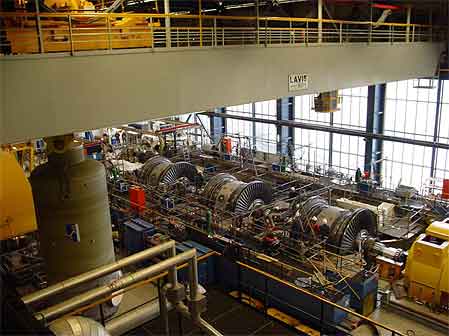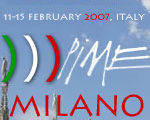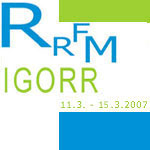
OUTPUT AT THE BORSSELE NUCLEAR POWER PLANT BORSSELE
(KCB) INCREASED BY 35 MWe
On December 10th 2006 the nuclear
power plant Borssele KCB (PWR) of EPZ was connected to the public
electricity grid again with 35 MWe net more.
In 2003 EPZ, the owner of the Borssele nuclear
power plant decided to carry out a feasibility study for increasing
the output of the plant by improving efficiency and not by changing
the reactor power.
The study concluded, supported by references,
that today’s turbine technology (knowledge of materials
and 3D-blade design) allows a power increase with attractive ROI
time on condition that the main interfaces (turbine table foundation,
condensers and main steam feeding) are not changed and that the
new process parameters do not effect these interfaces in a negative
way.
It has to be noted that the old turbine installation
had been in operation since 1973 and was still in good condition.
In 2004, the study was changed into a project
which focused on how the power increase must be possible within
the given boundaries and has to be done during the already planned
refueling outage at the plant at the end of 2006. The outage period
had been planned for a longer period than usual due to a lot of
planned, partly obligatory inspections.
During spring 2004, EPZ asked the European Commission to publish
a general invitation to tender for this project.
In 2002, two extreme short cuts on the public
electricity grid lead to a speeding up of the ageing of the winding
heads of the generator stator. The decision was made to change
the generator stator (rewinding took too much operation time)
also during the same outage period, having realised that this
activity would have to take place at the same location as the
turbine modernization with the same crane, which could have caused
logistical problems.
In February 2005, Siemens received the order
from EPZ to realize the power upgrade from 450 MWe up to 485 MWe
net output and the change of the generator stator during the outage
at the end of 2006.
The power upgrade consisted of changing the
inner turbine parts (blades, which means new rotors and inner
casings) for the HP and 3 LP turbines, to install new water separators
and to bring in a new state-of-the-art I&C control/protection
and automatic test system.
The upgrade and change of the generator stator
had to be done at the plant starting on October 21st
2006 and had to be ready for commissioning within 36 days.
The new blade design gives a power upgrade at the HP turbine
section of 5, 3 MWe and 28 MWe on the 3 LP turbine sections.
The change of the water seperators (separated
from pre-heaters but in series) from centrifugal type to collision
type (power vanes), which leads to a more effective water separation
from the exit steam from the HP turbine brings 1, 7 MWe.
The advantage of bringing in the state-of-the-art
I&C is to minimize the necessary hydraulic oil control system
(prevention against fire hazard), to solve the foreseen lack of
spare parts and the running out of skilled maintenance personnel.
Siemens carried out the project together with
the sub-contractors for the water separators (Areva, Balcke Dürr
and Exotech) within the contractually agreed deadline of 36 days.
After an extensive commissioning program, already
pre-tested on the KCB’s full scope simulator (which was
adjusted for the new installation), EPZ took over the new turbine
installation for testing and normal operation on December 10th
2006 with an extended power output of 35 MWe net.

Machinefloor: inner parts of 3 LP turbines, in
crane hook: new waterseparator
|






